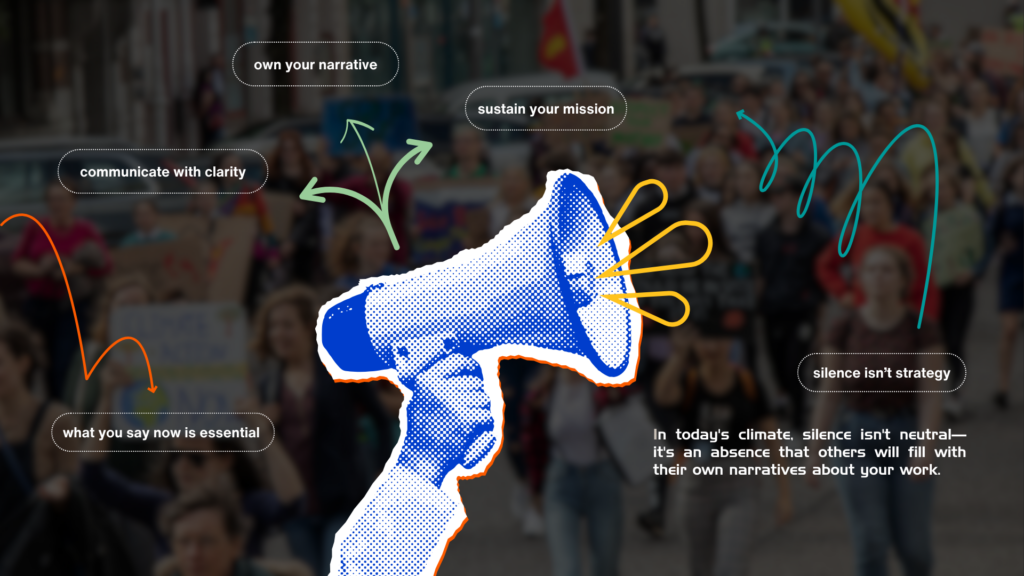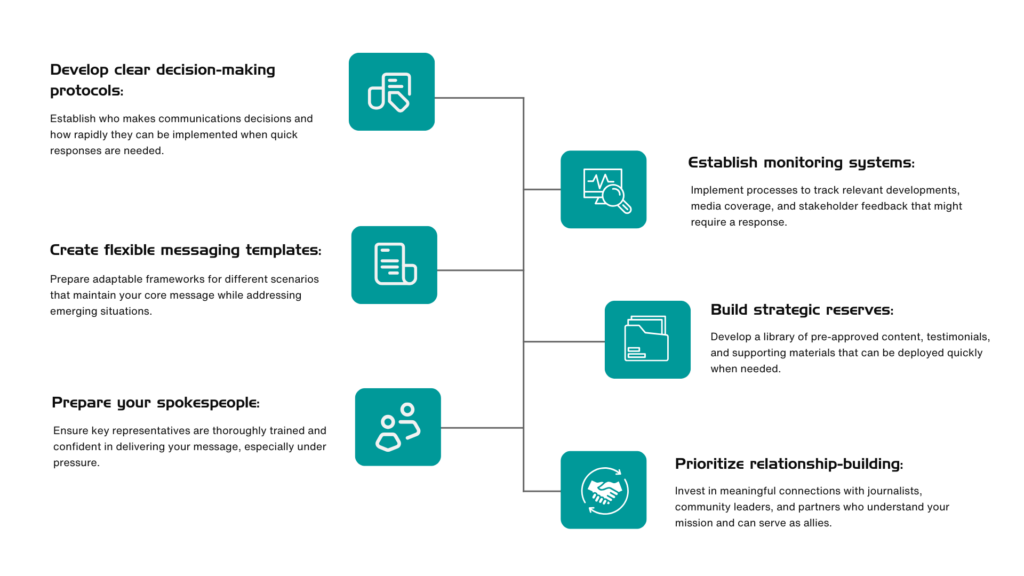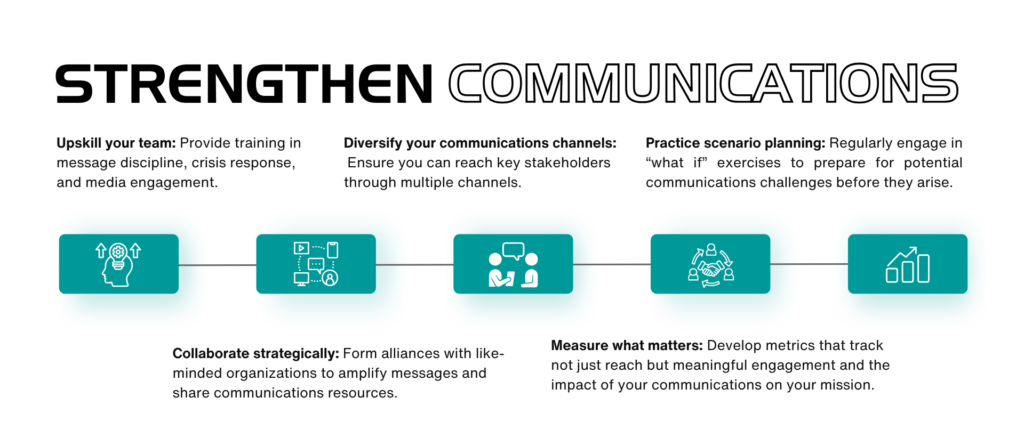
We can’t control the uncertainty. But we can control how we respond.
This year has started with dramatic shifts in policy and governance that impact organizations with social missions. We’re witnessing substantial changes to the economy, education, healthcare, and democratic institutions that challenge many organizations’ core values and the communities they support.
For purpose-driven leaders, a sound communications strategy isn’t a luxury—it’s essential infrastructure.
Whether you choose to publicly advocate for your mission, work strategically behind the scenes, are facing a crisis, or are still determining which approaches best suits your needs right now, one fundamental truth remains constant: If you don’t define your story and share your values with the audiences that matter most to you, someone else will fill that void—potentially in ways that will undermine your work.
In this environment, communicating strategically with intention and clarity is non-negotiable. That’s why we put together this guide to help organizations like yours navigate this moment with clarity and confidence.
So, where do you start?
Take Stock: Assess Your Communications Needs
The current environment holds both risk and opportunity—organizations must evaluate their needs to respond effectively. Before launching any communications initiative, consider which approach best advances and protects your core mission.
Communication Approaches
For organizations ready to take a public stance. This approach means clearly articulating your values, developing pointed messaging that addresses current challenges, and positioning your organization as a vocal leader. It requires strong messaging discipline, spokesperson preparation, and a willingness to engage directly in the public discourse.
For organizations that prefer working behind the scenes while maintaining impact. This approach focuses on carefully targeted communications to specific audiences, developing strategic partnerships, and advancing your mission through coalition building rather than public advocacy. It allows you to remain true to your values while minimizing potential backlash and can help prevent crises before they begin.
For organizations preparing for and responding to immediate challenges. Crisis communications is about protecting your mission, your organization, and your communities during turbulent times by developing protocols to respond to threats, and building the resilience and strategies needed to withstand attacks. It provides a framework for making difficult decisions about when to speak out versus when to focus on your core work.
Each approach, or a combination of them, offers distinct advantages depending on your organization’s mission, capacity, and risk tolerance. The right strategy aligns with both your organizational identity and the needs of the communities you serve.
Inaction is not an option—even organizations working quietly must communicate intentionally with their constituencies, donors, partners, and communities. Without clear communication, misinterpretations flourish, trust erodes, and your mission becomes vulnerable to distortion. In today’s climate, the stakes are too high for ambiguity.
Whether you choose public advocacy, strategic engagement, or crisis navigation, effective communication isn’t just good strategy, it’s essential to preserving and possibly enhancing your ability to serve your mission in increasingly challenging times.
From Strategy to Action
Once you’ve selected your communications approach, the next step is putting your strategy into action. Regardless of which approach you’ve chosen, proactive communication will be essential to maintaining trust with your stakeholders and advancing your mission in this challenging landscape.
- Rearticulate your mission in the current context: Ask yourself, “What does our work mean today?” The answer may have evolved from even a few months ago.
- Connect your values to current challenges: Help your audience understand how your organization’s core principles relate to today’s most pressing issues.
- Provide context and meaning, not just information: While some of your audiences may rely on you for news and updates in your field, they’re also looking to you for interpretation, context, and guidance. They need you to help them understand what developments mean for your shared mission, how to respond effectively, and where to find hope in challenging circumstances. Your unique position allows you to transform information into meaningful perspective that guides action.
- Maintain consistent presence: Establish a regular cadence of communication that your stakeholders can rely on, especially during turbulent times
Build a Resilient Communications Framework
Just as physical infrastructure must withstand pressure, your communications framework should function reliably during times of heightened tension and scrutiny.
The following framework comes from crisis communications strategies we develop for organizations. Having these elements in place is not only imperative if a crisis hits, but also invaluable in proactively shaping your narrative before you’re in the thick of it—ensuring you define your story before others can define it for you.

Strengthen Your Communications Capacity
The organizations that will navigate this period most effectively are those that treat communications as a strategic priority rather than an afterthought.

This Moment Requires Strategic Clarity
While we cannot control the uncertainty surrounding us, we absolutely can control how we respond to it. The organizations that will succeed in advancing their missions during this challenging period will be those that embrace communications as a core strategic function.
What worked in previous years may no longer apply. Now is the time to revisit, refine, and recommit to a communications strategy built for today’s realities. This means:
Clearly articulating your values and how they inform your work
Choosing the communications approach that best serves your mission and goals
Building resilient communications systems that can adapt to changing conditions
- Proactively engaging with your stakeholders rather than waiting for “better times”
Continually developing your team’s communications capabilities
Don’t wait until the dust settles—it may not for quite some time. Instead, meet this moment with clarity, purpose, and action. Your mission deserves nothing less than a communications strategy as committed and resilient as the work you do.
At EMC Communications, we specialize in helping mission-driven organizations navigate precisely these challenges. Our team brings decades of experience developing communications strategies that protect and advance critical work in complex environments. Whether you need a comprehensive communications framework or targeted support for specific challenges, we’re ready to help you communicate with impact and intention.

